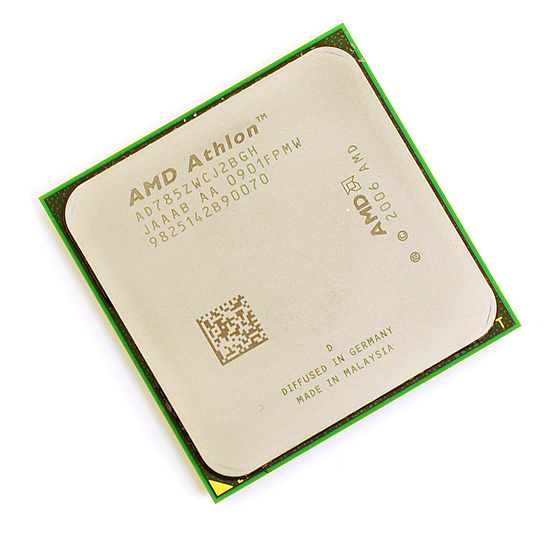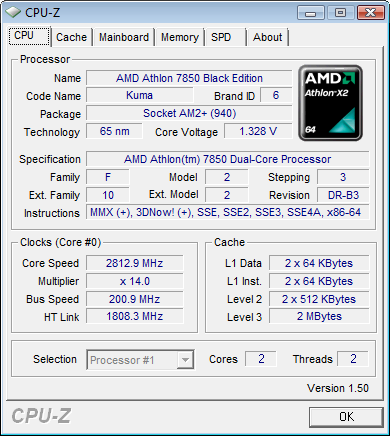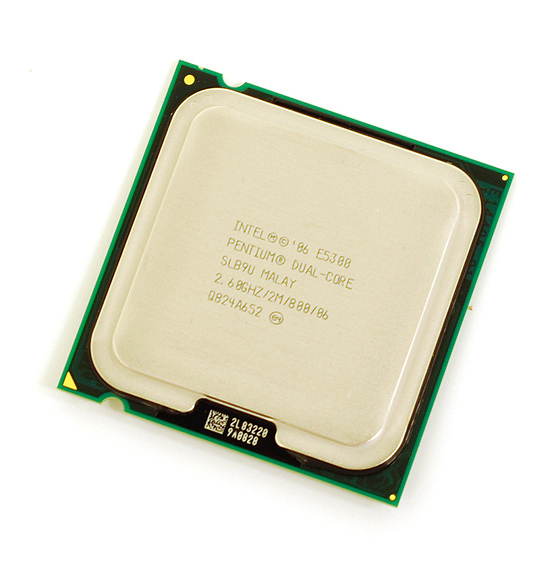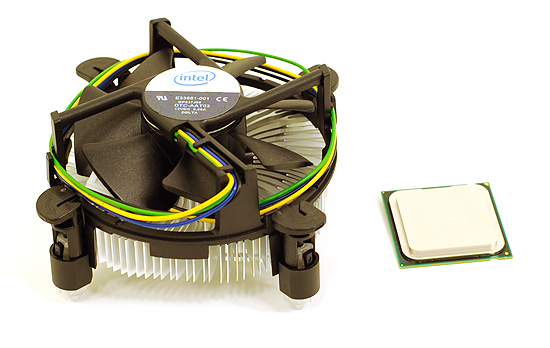AMD Athlon X2 7850 vs. Intel Pentium E5300: Choosing the Best $70 CPU
by Anand Lal Shimpi on April 28, 2009 11:00 AM EST- Posted in
- CPUs
AMD celebrates its 40 year anniversary next month, and the Athlon brand turns ten shortly thereafter. What better way to celebrate than by releasing a rebadged 65nm Phenom processor with two cores disabled at $69? Er, or, I guess they could’ve sent a cake.
It’s called the Athlon X2 7850 and it actually has very little in common with the old Athlon 64 X2s. As I mentioned, these are rebadged 65nm Phenom processors with two cores disabled. The table below should give you a good comparison between the die size and transistor count of the original Phenom compared to the new Athlon X2:
| Processor | Manufacturing Process | Die Size | Transistor Count |
| AMD Phenom X4 9950 | 65nm | 285 mm2 | 450M |
| AMD Athlon X2 7850 | 65nm | 285 mm2 | 450M |
There’s no surprise that the specs are identical, because the processors are identical. AMD simply disables two of the Phenom’s four cores in production before shipping the parts.
In its heyday the original Phenom never broke 2.6GHz, but with a fully mature 65nm process and only two functional cores AMD is able to clock these parts higher. The first dual-core Phenom derivative was the Athlon X2 7750 and it ran at 2.7GHz. In AMD’s tradition of introducing far too many CPUs, today AMD expands the list with a 2.8GHz Athlon X2 7850.

Once again this is the original Phenom processor; none of the advancements found in the Phenom II are included - it also means that the architecture doesn’t make quite as much sense.

It's a Socket-AM2+ Processor
The original Phenom architecture was designed to be used for quad-core processor designs, hence the use of a large shared L3 cache alongside private L2 caches. With only two cores, many of the benefits of this architecture are lost. Intel discovered that the ideal dual-core architecture featured two levels of cache with a large, fast, L2 shared by both cores. AMD and Intel came to the conclusion that the ideal quad-core architecture had private L2 caches (one per core) with a large, shared L3 cache. The Athlon X2 7850 takes the cache hierarchy of the ideal quad-core design and uses it on a dual-core processor.

To make matters worse, it does so with an incredibly small L3. Intel found that on its Nehalem processor each core needed a minimum of 2MB of L3 cache for optimal performance. With Phenom II AMD settled on 1.5MB L3 per core. The original Phenom gave each core 512KB of L3, or in the case of a dual-core derivative 1MB of L3 cache. Again, not ideal.
But it only costs $69.
And things should be easier for AMD at the $69 price point - there’s no Nehalem to worry about down here, only cache starved Core 2 processors. Priced at $74 we have Intel’s Pentium E5300.
It’s a Difference of Cache
The Athlon X2 7850 is based on the original 65nm Phenom core, but with only two cores enabled. That means we’ve got a 64KB L1 data cache, 64KB L1 instruction cache and a 512KB L2 cache per core. There’s also this catch-all 2MB L3 cache, but it’s unfortunately very high latency by comparison.

The Pentium E5300
The Pentium E5300 is a trimmed down version of Intel’s 45nm Wolfdale core. Each core has a 32KB L1 data cache and a 32KB L1 instruction cache, smaller than the Athlon X2. The L2 cache is shared between the cores and is 2MB in size. It takes just as long to access data from Intel’s 2MB shared L2 as it does to get data from AMD’s 512KB L2. Intel does not have an L3 cache but it also doesn’t have an on-die memory controller, so final accesses to memory are a lot slower on Intel’s hardware.

It's all LGA-775
AMD has more cache but it’s slower than Intel’s, once you get out to main memory the Athlon X2 can get to data quicker but the E5300 has the benefit of more advanced prefetchers.

The E5300 is a 45nm chip meaning it can be cooled by Intel's low profile boxed heatsink
Intel’s architecture also has a wider 4-issue front end compared to the Athlon X2. The execution advantage should go to Intel. With a higher IPC, Intel doesn’t need to run at the same clock speeds to outperform AMD. However with an on-die memory controller, the Athlon X2 could pull ahead in applications that don’t fit nicely within the E5300’s L2 cache.
While the Phenom II has been enjoying clear victories over Intel’s equivalently priced processors in the higher end space, it looks like crowning a winner at $70 will take a little more work.










55 Comments
View All Comments
just4U - Tuesday, April 28, 2009 - link
I don't agree about intel being the clear choice, (enthusiast or otherwise)You have to factor in boards being used to. Chances are most that are looking for a bottom feeder budget build will be using integrated chipsets. The 780g/v brings so much more to the table over what we currently get from intel offerings..
That was a key sticking point for me.. and I think it really makes the choice a hard one to make unless your brand loyal, or a overclocker looking for a cheap cpu based around a competent setup.
nubie - Wednesday, April 29, 2009 - link
Depends on what you need, I went for a 650i motherboard with a single PCIe slot for an 8600GTS ( the 2ghz ram actually seems to help with the 128-bit bus). It was $40, and you can get that deal yourself.I doubt for $140 you can beat a 3.3-3.4 ghz core2 with an 8600GTS.
soydeedo - Tuesday, April 28, 2009 - link
Yeah, that's what I was thinking.Zaitsev - Tuesday, April 28, 2009 - link
I was hoping to see a few words on OCing as well. I mean, having two cores disabled should yield some more headroom than the quad core parts, right?Anand Lal Shimpi - Tuesday, April 28, 2009 - link
I didn't have time to test overclocking for this article but if there's enough demand we can definitely look at how the two compare. The E5300 has a good amount of headroom thanks to its 45nm process, I'd expect the standings to remain the same if not widen in favor of Intel.Take care,
Anand
cpeter38 - Wednesday, April 29, 2009 - link
Please do OC the chip ...crimson117 - Tuesday, April 28, 2009 - link
OC results on these two budget CPUs would be great - but it'd be best if it were normalized somehow...1. Same price-class motherboards, around $100 or less to match the low-cost CPUs
2. Same exact ram modules
3. Same heatsink, or limit it to included stock heatsinks
, and re-run just a few choice benchmarks.
Would make for a great blog post :)
Viditor - Wednesday, April 29, 2009 - link
While you're at it, you should unlock the other 2 cores as well...http://www.atomicmpc.com.au/News/143621,amd-x2s-ar...">http://www.atomicmpc.com.au/News/143621,amd-x2s-ar...
johnsonx - Wednesday, April 29, 2009 - link
I've read dozens of articles and posts claiming that you can unlock the extra core(s) in the new X2's and X3's, and exactly ZERO telling how to actually do it. Is this some sort of urban legend?ssj4Gogeta - Tuesday, April 28, 2009 - link
Yes we'd definitely like to see OC results. I'm sure after OC'ing both chips to their max. gaming performance will be significantly better on the Intel part too.